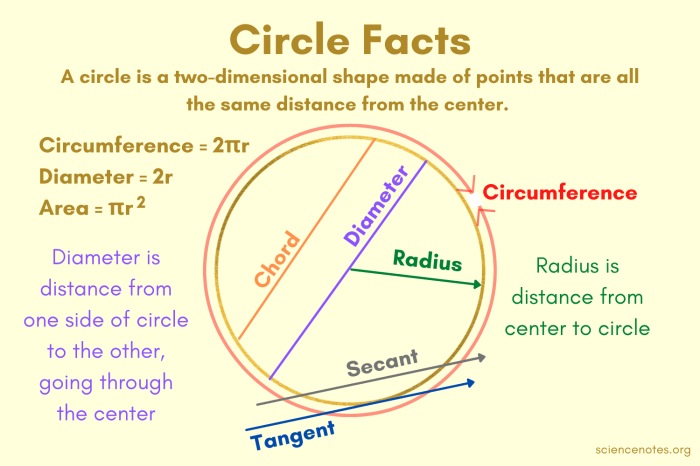Embark on a captivating journey with the Circles Area and Circumference Coloring Activity, where the beauty of mathematics meets the joy of art. This hands-on activity not only fosters a deep understanding of circle properties but also inspires creativity and artistic expression.
Through interactive coloring, students will explore the fundamental concepts of area and circumference, unravel the relationship between radius and diameter, and discover the practical applications of circles in various fields.
Area and Circumference Basics
Circles are plane figures with every point on the boundary (circumference) equidistant from a fixed point (center). Understanding the area and circumference of circles is fundamental in geometry and various applications.
Area, denoted by A, is the measure of the enclosed space within the circle. It is calculated as A = πr2, where ris the radius of the circle (the distance from the center to any point on the circumference).
Circumference, denoted by C, is the perimeter or distance around the circle. It is calculated as C = 2πr.
Formulas for Area and Circumference
| Formula | Description |
|---|---|
| A = πr2 | Area of a circle |
| C = 2πr | Circumference of a circle |
Hands-on Coloring Activity
This activity provides a hands-on approach to understanding circles and their properties.
Materials
- Printable worksheet with circles of different sizes
- Coloring utensils (crayons, markers, etc.)
- Ruler or measuring tape
Instructions
- Measure the radius of each circle using the ruler or measuring tape.
- Calculate the area and circumference of each circle using the formulas A = πr2and C = 2πr.
- Record your measurements and calculations in the table provided on the worksheet.
- Color the circles according to the specified instructions or your creativity.
Exploring Circle Properties: Circles Area And Circumference Coloring Activity

Relationship between Radius and Diameter
The diameter of a circle is the distance across the circle through the center, passing through two points on the circumference. The diameter ( d) is twice the radius ( r), expressed as d = 2r.
Drawing Circles with a Compass
A compass is a drawing tool used to create circles of different sizes.
- Set the compass to the desired radius.
- Place the compass point at the center of the circle.
- Rotate the compass around the center point to draw the circle.
Real-World Examples of Circles
- Wheels of vehicles
- Clock faces
- Circular windows
- Sports balls
- Planets and stars
Artistic Applications
Circles play a significant role in art and design.
- Composition: Circles can create balance, harmony, and movement in compositions.
- Perspective: Circles can be used to create the illusion of depth and distance.
- Symbolism: Circles can symbolize unity, infinity, and wholeness.
Famous Artworks Incorporating Circles, Circles area and circumference coloring activity
- The Starry Nightby Vincent van Gogh
- Mona Lisaby Leonardo da Vinci
- The Persistence of Memoryby Salvador Dalí
Cross-curricular Connections
Math
- Calculating area and circumference of circles
- Exploring the relationship between radius, diameter, and circumference
- Using circles in geometry proofs
Science
- Circular motion in physics
- Modeling the shape of cells and atoms
- Using circles to understand planetary orbits
Geography
- Mapping the Earth’s surface using circles (great circles)
- Understanding the shape of continents and oceans
- Navigating using the compass
FAQ Explained
What is the purpose of the Circles Area and Circumference Coloring Activity?
To provide an engaging and interactive way for students to learn about the area and circumference of circles while fostering artistic creativity.
How does the activity incorporate artistic elements?
Students will create their own circle-based artwork, showcasing their understanding of circle properties and artistic expression.
What real-world examples of circles are discussed in the activity?
Examples may include wheels, clocks, and the Earth’s orbit, demonstrating the practical applications of circles in various fields.